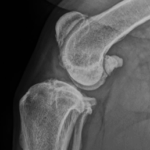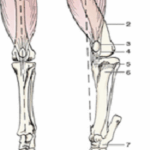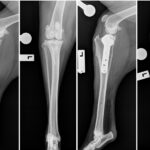
Marvin at the beach.
As the proud owner of a poorly-constructed dog, I have had a lot of first-hand experience in treating arthritis. When we first rescued Marvin, we noticed that one front leg was held at a strange angle when he was lying down. We took some xrays of his joints and diagnosed him with Elbow Dysplasia, and he already had some early arthritic changes occurring. He was only 12 months old, so we knew we were going to have a lifetime of managing this problem.
Marvin is now around 10 years old, and can still chase the ball on the beach and go for a short run with us. This is how I have managed his condition for so many years.
Weight control
This will make more of a difference than any medication. Excess weight puts a lot of strain on joints, so contributes to both the development and clinical signs of arthritis. I find that some dogs with mild arthritis can be maintained medication-free simply by getting them back to a healthy weight. If your pet is struggling to lose their love handles, or nurses run free weight clinics to help them get back to an ideal size.
Dietary Changes
Initially, I used products such as Pernease, which is basically a glucosamine/chondroitin and green lip muscle supplement. However, I like things to be as simple as possible when it comes to caring for my dog, so I now feed him Royal Canin Mobility CP2+, which is designed as a complete diet with supplements to help with arthritis control.
Zydax Injections
This is known as a Disease Modifying Osteoarthritis Drug (DMOAD). These are a course of injections given weekly for 4 weeks, which is then repeated every 6 months and can help arthritis by:
- Stimulating cartilage producing cells to produce healthy cartilage
- Slowing cartilage damage by destructive enzymes
- Stimulating joint capsule cells to produce lubricating joint fluid
- Reducing swelling and blocks inflammatory processes
- Improving blood flow and nutrition to joint structures
For Marvin, I have been using these injections from when we first diagnosed him with elbow dysplasia at around one year of age, and I believe these injections have had a massive impact on maintaining mobility and quality of life for him.
Non-steroidal Anti-inflammatory Drugs (NSAIDs)
Think of these as “Nurofen for dogs” (PLEASE NOTE: Ibuprofen can be very toxic to dogs so do not use Nurofen or any other human medications without a discussion with your vet). These medications are pain killers and also reduce inflammation in the joints. We generally use these medications once everything else is not keeping the dog mobile and pain-free. For Marvin, he is now on these medications daily. When he’s had an extra-busy day I will give him an additional dose to make sure he doesn’t pull up sore the next day. (Once again, only give an extra dose if your vet has informed you it is safe to do so).
Other Medications
When the above steps aren’t enough to control the discomfort, additional medications can be used. We tailor the treatment protocol to your individual pet’s needs and responses, so these steps are best discussed with your vet rather than general advice being given here.
The Future
We live in exciting times, and it will be interesting to see where treatment options go in the future. Stem cell treatments, joint replacements, and new medications are likely to be developed and become available over the next few years. We look forward to being able to offer even more effective treatments in the years to come.
As you can see, there is a lot we can do to help keep your pet mobile and comfortable for many years. If you’re concerned about your pet’s joints or mobility, please give us a call or book an appointment online.



